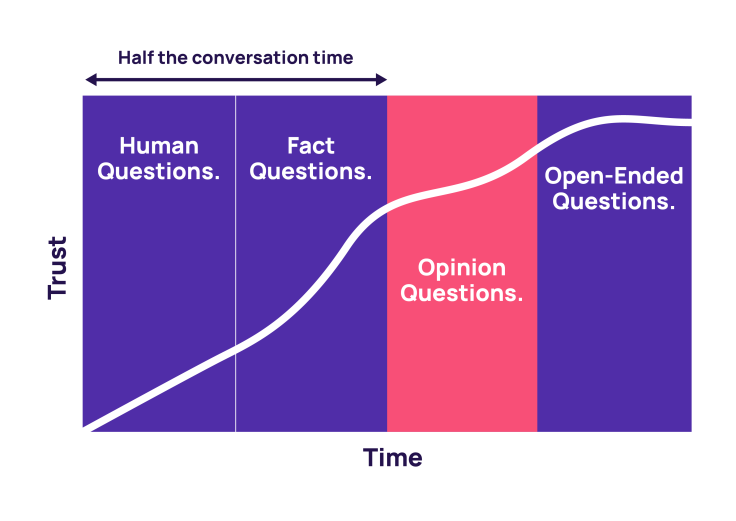Tips for having research conversations

Researchers spend a lot of their day talking to people, trying to understand them and empathize with their experiences. They're not the only ones in the organization speaking to people–product managers, designers, customer success, marketing, and sales frequently chat with users and customers.
Researchers can find this challenging because it’s hard to determine if other departments ask unbiased questions and capture useful data. It can be daunting to figure out what questions will result in relevant insights that’ll later be leveraged for better research.
The more people who understand research techniques, the more data can be added into the pipeline and leveraged when generating insights. This prospect makes it incredibly important to educate stakeholders on how to best conduct research sessions and capture the correct data.
The most common way stakeholders will research is by conducting an in-depth interview. Although having a conversation with someone may seem reasonably straightforward, leveraging tested research techniques maximizes the output and potential for insights.
Build rapport
Building rapport is essential when connecting with customers, especially when you want them to open up to you on tough topics. The same way you wouldn’t share your innermost secrets on a first date, building rapport takes time. It shouldn’t come as a surprise that participants won’t share their real thoughts with you immediately if you’ve never spoken to them before.
Structure your interview into four question segments - human, fact, opinion, and open-ended. The goal of the first half is to build rapport. Ensuring you have built trust means that customers will provide honest answers and opinions.

1. Human questions
The first set of questions is to get to know the participant as a human. You might ask them about how their day is going or to shed light on their role. These questions should be easy to answer and help break the ice. You might also use this time to share more about you, your background, and why you’re talking in the first place.
2. Fact questions
Fact-based questions are where there is a clear and indisputable answer, and help make the participant feel more comfortable with the conversation. You can begin to set the context of what you’d like to hear from the participant, such as their usage with a product.
3. Opinion questions
You’re now able to start asking the participant for their opinion, pain points, or frustrations with products or experiences. They will generally provide more insight because of the context you’ve set in your previous questions.
4. Open-ended questions
Keep it open, so your participant can share their perspective or opinions on anything that you may not have covered as part of your question set, but they trust sharing with you. Ensure you keep enough time for this as there is often something unexpected that the participant shares that may lead to new insights.
Always be closing
When it comes to interview questions, there are open questions (those with free-form answers) and closed questions (those with a yes or no response).

You generally funnel from open to closed questions on the various topics. Be careful not to start with closed or leading questions as it can bias participants’ answers towards your assumptions. The way you move from open to closed questioning is through three stages:
The discovering stage is where you ask open-ended questions, opening up the possibility for a range of answers.
The validating stage is where you ask probing or clarifying questions related to the previous responses.
The paraphrasing stage is where you repeat the answer back to the participant to make sure you have a common understanding.
This approach ensures you can diverge on a focus area, then converge on a specific response, and then verify that you have a shared understanding with the participant.
Don’t assume
One of the most critical traits of a researcher is the ability to build empathy for your participant. Having compassion helps you walk in someone else’s shoes by creating a shared understanding of your experiences, feelings, perspective, and needs. To truly build empathy for another person, you need to challenge your assumptions and biases because your participant’s context will be different from your own.
The easiest way to help challenge your assumptions is by asking why—a lot. The five whys capture more context about the responses and curiously looking for the deeper why helps you either prove or disprove your assumptions.
Listen
Active listening is when you are engaged, present, and responding to your participant. Hearing what the participant is telling you is not just listening to what they say. You must consider what you are thinking, doing, and saying throughout the interview:
Think: When you’re thinking - be curious. If something is worth digging into, don’t feel that you have to stick to your script, adapt and change based on what you’re hearing. Remember, you’re having a conversation, and opening that up might enable you to find some unexpected insights.
Do: Watch what you’re doing and monitor your body language - are you leaning in, are your arms crossed, and do you look interested? Being open and engaged will make your participant more receptive to having a conversation. Additionally, consider cultural norms and how this may factor into how you have a chat, especially if your participant comes from a different culture.
Say: When you’re responding or leading in the conversation, use paraphrasing to confirm your understanding (closing your questions) and make sure you’re exploring the problems in the solutions your participants are identifying.
If I had asked people what they wanted, they would have said faster horses.
In the same way that Henry Ford* wanted to innovate beyond faster horses, many participants will try to solutionize their problems based on their context and assumptions. Rather than taking their solution at face value, it’s important to drill into the underlying pain point. You can do this by using the five whys technique to understand why a specific solution is so important to them and what problem it is solving.
Find patterns in insights
I’ve lost count of the number of times people have wanted to make product changes based on a single customer conversation. Instead, you should have multiple discussions with various customers to help you identify the commonalities and differences that will help you build once to serve many.
The number of conversations needed to build confidence primarily depends on the type of methodology used and the number of different research segments. Nielsen Norman Group suggests testing with five users in conversations with a usability focus. For more exploratory research, you should try to aim for eight to 10 participants per segment, as this will help you identify strong patterns between your participants.
It is incredibly important to set expectations with your stakeholders on who you chose to include and exclude in the interview phase. Indicating that you have complete coverage over your user base while only talking customers from a single industry can bias the findings you present to your stakeholders.
Identifying patterns in your findings is crucial to capture insights and genuinely understand customers through their behaviors and attitudes. As you capture your insights, you should consider what is behavioral (i.e., what they do) and what is attitudinal (i.e., what they say).
Be careful about what people say they do, as this is an attitudinal perspective instead of a true behavioral reflection. Margaret Mead said it best:
What people say, what people do and what they say they do are entirely different things.
Educating stakeholders on how to run their research can hurt a researcher’s output in the short term, but the value gained is in the potential for increased data capturing, which ultimately increases the number of available insights.


